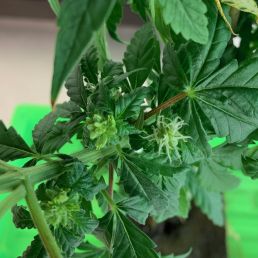Guest post by Hayley McKay
The commercial cannabis industry is facing a looming problem: it doesn’t have the ability to cultivate cannabis efficiently. Sure, growers have tried to co-opt basement grow-op techniques for large scale production, but fundamental plant science is still missing. Not enough is known about Cannabis sativa biology. In my work as a graduate student in the Lumba Lab, I’ve been contributing to laying the groundwork for better understanding C. sativa’s flower development since the cannabis industry hinges on the harvest of unfertilized female flowers.
Specifically, my research focuses on an issue plaguing commercial cultivators at the moment: how can a female cannabis plant produce a male flower?
While relatively uncommon in the animal kingdom, hermaphroditism is a frequent occurrence among plants, meaning one plant possesses both male and female sex organs. It is much more common for flowering plants to be hermaphroditic (‘monoecious’) than it is for plants to have distinct male and female individuals (‘dioecious’). Cannabis sativa is considered a dioecious species but can sometimes produce male flowers on female plants and vice versa. This is a problem for the industry and currently there is no real understanding of how or why this hermaphroditism happens.
Industrial cultivation of C. sativa relies on harvesting unfertilized female flowers because they contain the highest levels of medically and recreationally important cannabinoids like CBD and THC. If even a single male plant is present in a crop, it will release its powder-like pollen and fertilize a large portion of the female flowers, rendering them useless and decreasing yield significantly.
Although efforts are made to ensure only female plants are grown, cultivators are limited to visual detection. But male and female plants are nearly impossible to visibly differentiate before they flower, and once a male flower emerges, it’s too late. Even more difficult to identify are the female plants producing viable male flowers, or ‘hermies’ as growers like to call them.
These hermaphrodites are puzzling. We know C. sativa, like humans, has a pair of sex chromosomes where females have two X’s and males have an X and a Y, but these chromosomes don’t seem to be important in determining which sex of flower is produced by a plant. This means genetic markers targeting the Y chromosome, for example, are not helpful for identifying a male flower-producing plant, since a female plant with no Y chromosome can produce a male flower too.
So how do these hermaphrodites arise? The short answer: we don’t know. It has become clear the plant hormone ethylene is playing an important role in the development of female flowers. When genetically female cannabis plants are treated with an ethylene inhibitor, they will produce male flowers, but the molecular mechanism underlying this sex determination switch remains unclear.
Through molecular and morphological analysis, my research seeks to uncover ethylene’s role in C. sativa’s sex determination system. Eventually, my team aims to use these findings to develop a reliable, easy-to-use method to identify and remove male-producing plants to reduce waste and improve yield in a commercial environment.

